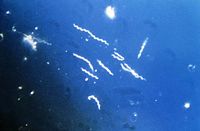Borrelia burgdorferi: Difference between revisions
imported>Daniel Mietchen (+EZnotice) |
imported>Nashid Islam No edit summary |
||
| Line 3: | Line 3: | ||
{{subpages}} | {{subpages}} | ||
[[Image:Borrelia burgdorferi.jpg|200 px||right|]] | [[Image:Borrelia burgdorferi.jpg|200 px||right|]] | ||
{{Taxobox | color=violet | {{Taxobox | color=violet | ||
| Name = Borrelia burgdorferi | | Name = Borrelia burgdorferi | ||
| Line 57: | Line 59: | ||
==Cell structure and metabolism== | ==Cell structure and metabolism== | ||
B. burgdorferi are long gram negative spirochetes. They are flexible helical cells and are much longer than they are wide. They usually have a length of 20-30um but a width of only 0.2-0.3um. The organism is motile with both rotational and translational movements, and the coiling of the cell is regular. | |||
==Ecology== | ==Ecology== | ||
Revision as of 15:58, 23 April 2009
For the course duration, the article is closed to outside editing. Of course you can always leave comments on the discussion page. The anticipated date of course completion is May 21, 2009. One month after that date at the latest, this notice shall be removed. Besides, many other Citizendium articles welcome your collaboration! |
| Borrelia burgdorferi |
|---|
| Scientific classification |
|
|
Description and significance
B. burgdorferi is a motile, two-membrane, spiral-shaped bacteria which is found mostly in North America and Europe. It's named after American scientist Willy Burgdorfer, who in 1982 isolated and determined the bacteria to be the causative agent of Lyme disease. Lyme disease is the most common tick borne disease in the US. [1]
Genome structure
B. burgdorferi has a complex genome containing linear DNA, accompanied by up to 20 circular as well as linear plasmids. A study in 1997 found the linear DNA to be composed of 910,725 base pairs (average G+C content of 28.6%), and at least 17 linear and circular plasmids with a combined size of more than 533,000 base pairs.
The chromosomes contains 853 genes encoding a basic set of proteins for DNA replication, transcription, translation, solute transport and energy metabolism, but no genes for cellular biosynthetic reactions. Of 430 genes on 11 plasmids, most have no known biological function.The biological significance of the multiple plasmid-encoded genes is not clear, although they may be involved in antigenic variation or immune evasion.
| Number | Percent | |
|---|---|---|
| Total Number of all DNA molecules: | 18 | 100.00% |
| Total Size of all DNA molecules: | 1443725bp | 100.00% |
| Total number of linear DNA bases: | 910,725bp | 63.1% |
| Number of chromosomal G+C bases: | 256551bp | 28.17% |
| Number | Percent | |
|---|---|---|
| Total genes: | 853 | 100.00% |
| Protein coding genes: | 793 | 93% |
| Genes assigned a role category: | 502 | 59% |
| Genes not assigned a role category: | 51 | 6.26% |
| Hypothetical genes: | 102 | 12% |
Cell structure and metabolism
B. burgdorferi are long gram negative spirochetes. They are flexible helical cells and are much longer than they are wide. They usually have a length of 20-30um but a width of only 0.2-0.3um. The organism is motile with both rotational and translational movements, and the coiling of the cell is regular.

